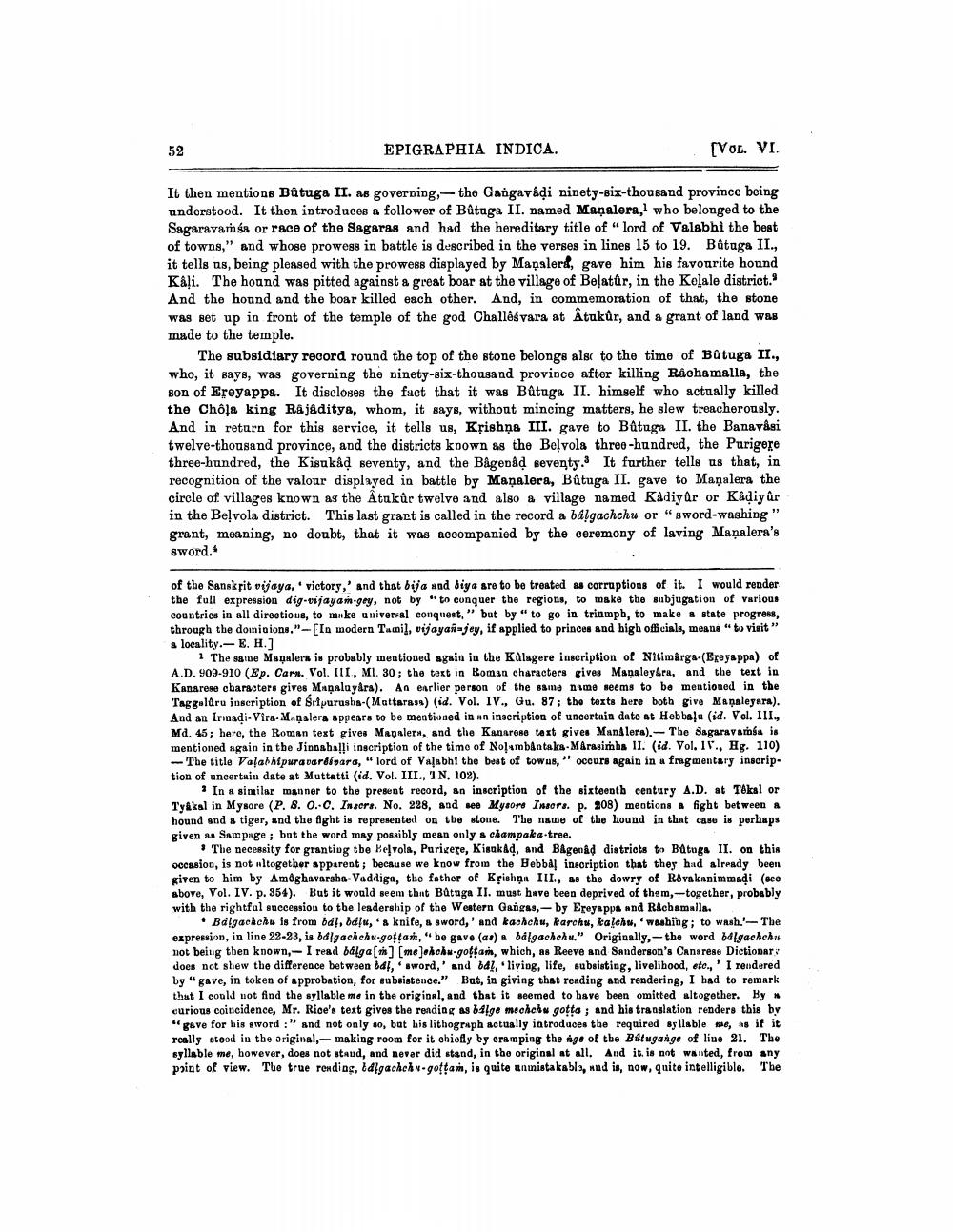________________
52
EPIGRAPHIA INDICA.
(VOL. VI.
It then mentione Butuga II. as governing,- the Gangavadi ninety-six-thousand province being understood. It then introduces a follower of Bûtaga II. named Mañalera, who belonged to the Sagaravamsa or race of the Sagaras and had the hereditary title of " lord of Valabhi the best of towns," and whose prowess in battle is described in the verses in lines 15 to 19. Batuga II., it tells us, being pleased with the prowess displayed by Mapslerd, gave him his favourite hound Kaļi. The hound was pitted against a great boar at the village of Belatur, in the Kolale district." And the hound and the boar killed each other. And, in commemoration of that, the stone was set up in front of the temple of the god Challeśvara at Atukûr, and a grant of land was made to the temple.
The subsidiary record round the top of the stone belongs als to the time of Butuga II., who, it says, was governing the ninety-six-thousand province after killing Rachamalla, the son of Eroyappa. It discloses the fact that it was Batuga II. himself who actually killed the Chôļa king Râjâditya, whom, it says, without mincing matters, he slew treacherously. And in return for this service, it tells us, Krishna III. gave to Batuga II. the Banavåsi twelve-thousand province, and the districts known as the Belvola three-hundred, the Purigere three-hundred, the Kisukad seventy, and the Bågedad seventy. It further tells us that, in recognition of the valour displayed in battle by Mañalera, Batuga II. gave to Mañalera the circle of villages known as the Âtukûr twelve and also a village named Kådiyûr or Kadiyûr in the Beļvola district. This last gract is called in the record a balgachchu or "sword-washing" grant, meaning, no doubt, that it was accompanied by the ceremony of laving Mañalera's sword."
of the Sanskrit vijaya, victory, and that bija und biya are to be treated as corruptions of it. I would render the full expression dig-vijayam-gey, not by " to conquer the regions, to make the subjugation of various countries in all directious, to make universal conquest,” but by "to go in triumph, to make a state progress, through the doinigions."-[In modern Tamil, vijayansjey, if applied to princes and high officials, means "to visit" a locality.- E. H.
1 The same Manalera is probably mentioned again in the Kälagere inscription of Nitimârga-(Ereyappa) of A.D.909-910 (Ep. Caru. Vol. III, MI. 30; the text in Roman characters gives Maņaleyra, and the text in Kanarese cbaracters gives Mamalayara). An earlier person of the same name seems to be mentioned in the Taggalúru inscription of Srpurushs-(Mattaraya) (id. Vol. IV., Gu. 87; the texts here both give Manalegara). And an Ingadi Vira Mañalera appears to be mentioned in an inscription of uncertain date at Hebbalu (id. Vol. III., Md. 45; here, the Roman text gives Magalera, and the Kanarse taxt gives Manilera).- The Sagaravaria is mentioned again in the Jinnahalli inscription of the time of NorbAntaka-Marasimha II. (id. Vol. 10., Hg. 110) -The title Valat Nipuravardipara, " lord of Valabhi the best of towus, ' occurs again in a fragmentary inscription of uncertain date at Muttatti (id. Vol. III., IN, 102).
? In a similar manner to the present record, an inscription of the sixteenth century A.D. at Tékal or Tykkal in Mysore (P. 8. 0. C. Insors. No. 228, and see Mysore Inscrs. p. 208) meotions a fight between a hound and a tiger, and the fight is represented on the stone. The name of the hound in that case is perhaps given as Sampage; bot the word may possibly mean only champaka-tree.
The necessity for granting tbe Bevola, Purivere, Kisakad, and Bagend districts to Batuga II. on this occasion, is not wltogether apparent; because we know from the Hebbal inscription that they had already been given to him by Amoghavarsha-Vaddiga, the father of Krishna III., as the dowry of Rêvakanimmadi (see above, Vol. IV. p. 354). But it would seem that Båtaga II. must have been deprived of them,-together, probably with the rightful succession to the leadership of the Western Gangas,- by Ereyappa and Richamalla.
* Bálgachchu is from bå!, odľu, '& knife, & sword,' and kachchu, karchu, kalchs, washing; to wash.' - The expression, in line 22-23, is bd gachchu.goftań, "be gave (as) a bálgachchu." Originally,- the word balgachchi not being then known,- I read bálgamm] [me]ekcw.gottam, which, as Reeve and Sanderson's Canarese Dictionary does not shew the difference between bal, sword,' and bal, living, life, subsisting, livelihood, etc.,' I rendered by "gave, in token of approbation, for subsistence." Bat, in giving that reading and rendering, I had to remark that I could not find the syllable me in the original, and that it seemed to have been omitted altogether. By # curious coincidence, Mr. Rice's text gives the reading as 641ge "gave for his sword : " and not only so, but his lithograph actually introduces the required syllable e, as if it really stood in the original, making room for it chiefly by cramping the age of tbe Bdugange of line 21. The syllable me, however, does not staud, and never did stand, in the original at all. And it is not wanted, from any point of view. The true reading, td gachchn.goftan, is quite unmistakabls, and is, now, quite intelligible. The




